Live Painting Event on World Food Day (Art Exhibition on 16 October 2011 at Cholamandal Artists Village, Chennai)
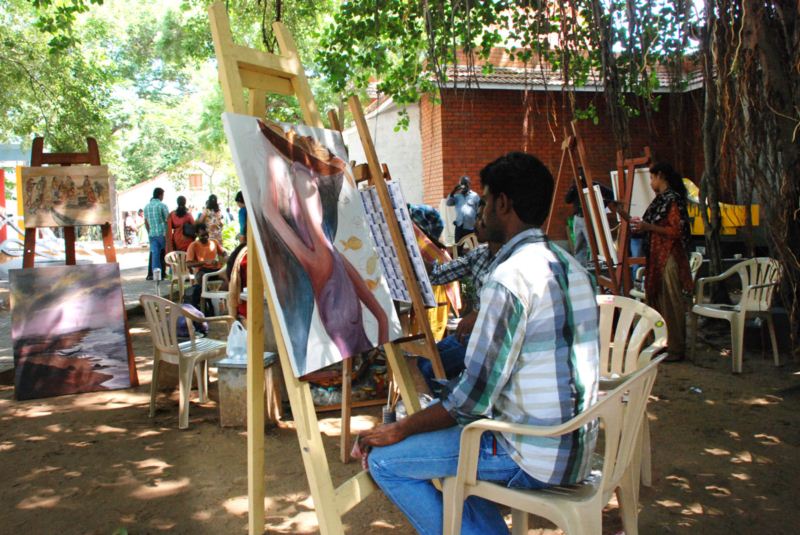 Twenty-one budding artists, pursuing their degrees from eminent Indian Art Institutions in Tamil Nadu, Puducherry and Karnataka,
exhibited their painting skills in the ‘Live Painting Event’ coinciding with the Art Exhibition on 16 October 2011 at Cholamandal Artists Village, Chennai.
Using different media, these young artists painted the lives and livelihoods of fisherfolk and their environment.
Each artworks are tribute to the brave fishers who toil against all odds to harvest nutritious fish food from the oceans.
Twenty-one budding artists, pursuing their degrees from eminent Indian Art Institutions in Tamil Nadu, Puducherry and Karnataka,
exhibited their painting skills in the ‘Live Painting Event’ coinciding with the Art Exhibition on 16 October 2011 at Cholamandal Artists Village, Chennai.
Using different media, these young artists painted the lives and livelihoods of fisherfolk and their environment.
Each artworks are tribute to the brave fishers who toil against all odds to harvest nutritious fish food from the oceans.
Life After Tsunami (Paintings
by children)
 India
India
 Sri Lanka
Sri Lanka
 Maldives
Maldives
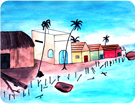 The
trauma of tsunami has inspired some remarkable child
art. The beautiful paintings drawn by children depict
their reactions to a catastrophe like tsunami and how
they view their immediate environment and the world
after the December 2004 Asian tsunami. Some 280 children
from 85 schools of coastal Tamil Nadu (India), Maldives
and Sri Lanka took part in the six on-the-spot art
contests organized by the Bay of Bengal Programme
Inter-Governmental Organisation during August-December
2005. The theme of the contest was “Life after Tsunami”. The
trauma of tsunami has inspired some remarkable child
art. The beautiful paintings drawn by children depict
their reactions to a catastrophe like tsunami and how
they view their immediate environment and the world
after the December 2004 Asian tsunami. Some 280 children
from 85 schools of coastal Tamil Nadu (India), Maldives
and Sri Lanka took part in the six on-the-spot art
contests organized by the Bay of Bengal Programme
Inter-Governmental Organisation during August-December
2005. The theme of the contest was “Life after Tsunami”.
Code of Conduct for Responsible Fisheries
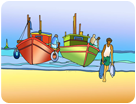 The
Code of Conduct for Responsible Fisheries (CCRF) is one
of the most important international instruments devised
for the management of the living aquatic resources of
our planet. This landmark instrument is voluntary,
standard-setting and is directed at everyone engaged in
the conservation, management and development of
fisheries. It aims at establishing principles and
standards of behavior for responsible fisheries and
aquaculture practices. The 12 drawings made by S Jayaraj,
Publications Officer, BOBP-IGO depict important themes
of the CCRF and their implementation by the
stakeholders. The
Code of Conduct for Responsible Fisheries (CCRF) is one
of the most important international instruments devised
for the management of the living aquatic resources of
our planet. This landmark instrument is voluntary,
standard-setting and is directed at everyone engaged in
the conservation, management and development of
fisheries. It aims at establishing principles and
standards of behavior for responsible fisheries and
aquaculture practices. The 12 drawings made by S Jayaraj,
Publications Officer, BOBP-IGO depict important themes
of the CCRF and their implementation by the
stakeholders.
Safety at Sea
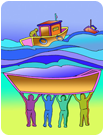 Fishers
who go out to sea risk death, injury, permanent
disability, ill-health, emotional trauma – their
occupation is by far the world’s most dangerous
occupation.How can we help? Experts suggest a slew of
measures. The aim: prevention, awareness, mitigation.The
12 attractive sketches, which form a part of the
BOBP-IGO’s 2008 table calendar, focus on the health and
safety of fishers.The credits for the drawings go to S
Jayaraj. Fishers
who go out to sea risk death, injury, permanent
disability, ill-health, emotional trauma – their
occupation is by far the world’s most dangerous
occupation.How can we help? Experts suggest a slew of
measures. The aim: prevention, awareness, mitigation.The
12 attractive sketches, which form a part of the
BOBP-IGO’s 2008 table calendar, focus on the health and
safety of fishers.The credits for the drawings go to S
Jayaraj.
Emerging issues in fisheries
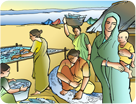 More
than 41 million fishers and fish farmers, most of them
from Asia, produce annually about 142 million metric
tonnes of fish – a major source of food, nutrition and
livelihoods for the world’s 6.5 billion people. But
fishers and fisheries are today in crisis, because of
resource depletion, falling catches, pollution and other
problems. These need to be tackled through systematic
management, scientific studies, better governance and
global co-operation. The drawings (by S Jayaraj) in the
2009 BOPBP-IGO’s table calendar highlight some of the
emerging issues in fisheries through words and sketches. More
than 41 million fishers and fish farmers, most of them
from Asia, produce annually about 142 million metric
tonnes of fish – a major source of food, nutrition and
livelihoods for the world’s 6.5 billion people. But
fishers and fisheries are today in crisis, because of
resource depletion, falling catches, pollution and other
problems. These need to be tackled through systematic
management, scientific studies, better governance and
global co-operation. The drawings (by S Jayaraj) in the
2009 BOPBP-IGO’s table calendar highlight some of the
emerging issues in fisheries through words and sketches.
Fishers of the bay: Faces of fortitude
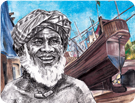 Fishers
in the Bay of Bengal face foes on both sea and land.
Their boats are small, they battle rough seas, and they
risk injury and even loss of life. On land, the problems
of daily living are formidable, but the fishers – men
and women – meet them with stoic courage. A few have
overcome all odds to rise out of poverty, serving as an
inspiration to others. The paintings (by S Jayaraj)
depicted in the 2010 BOBP-IGO’s calendar present the
many faces and moods – pensive, feisty, serious – of the
fishing community from Bangladesh, India, Maldives and
Sri Lanka. These painting are based on photographs taken
by Y S Yadava, Director, BOBP-IGO and S Jayaraj. Fishers
in the Bay of Bengal face foes on both sea and land.
Their boats are small, they battle rough seas, and they
risk injury and even loss of life. On land, the problems
of daily living are formidable, but the fishers – men
and women – meet them with stoic courage. A few have
overcome all odds to rise out of poverty, serving as an
inspiration to others. The paintings (by S Jayaraj)
depicted in the 2010 BOBP-IGO’s calendar present the
many faces and moods – pensive, feisty, serious – of the
fishing community from Bangladesh, India, Maldives and
Sri Lanka. These painting are based on photographs taken
by Y S Yadava, Director, BOBP-IGO and S Jayaraj.
Fishing Crafts of the Bay of Bengal
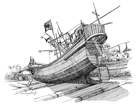 The
kattumarams, teppas and masulas of India, the chandis of
Bangladesh, the graceful orus of Sri Lanka, the dhonis
of the Maldives – they embody tradition, functionality,
diversity and beauty. Despite limitations in catching
and carrying capacity, these crafts capture the bulk of
the fish catch in the Bay of Bengal and sustain a few
million fishermen – and women from fishing communities
who market the catch. The drawings in the BOBP-IGO’s
2011 table calendar provide glimpses into these crafts,
which have been active for centuries and may well be
around a few more. The drawings were made by S Jayaraj
from photographs drawn from the photo-archives of the
BOBP-IGO. The
kattumarams, teppas and masulas of India, the chandis of
Bangladesh, the graceful orus of Sri Lanka, the dhonis
of the Maldives – they embody tradition, functionality,
diversity and beauty. Despite limitations in catching
and carrying capacity, these crafts capture the bulk of
the fish catch in the Bay of Bengal and sustain a few
million fishermen – and women from fishing communities
who market the catch. The drawings in the BOBP-IGO’s
2011 table calendar provide glimpses into these crafts,
which have been active for centuries and may well be
around a few more. The drawings were made by S Jayaraj
from photographs drawn from the photo-archives of the
BOBP-IGO.
Save the Sharks
(Paintings by children)
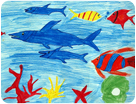 In
Maldives, shark fishing has given rise to conflicts with
the tourism industry and the tuna pole and line
industry, the two major income earners in the country.
In an attempt to reduce these conflicts and also protect
the shark resources, the Government of Maldives
(Ministry of Fisheries and Agriculture) has imposed ban
on shark fishing from early 2010. In an attempt to
further promote conservation of sharks, the Bay of
Bengal Programme Inter-Governmental Organisation and the
Ministry of Fisheries and Agriculture, Government of
Maldives, on 10 August 2009, conducted an art
competition for school students from nearby Islands of
Kuldhuffushi, Maldives. These Islands were once famous
for the shark fishery in Maldives. In
Maldives, shark fishing has given rise to conflicts with
the tourism industry and the tuna pole and line
industry, the two major income earners in the country.
In an attempt to reduce these conflicts and also protect
the shark resources, the Government of Maldives
(Ministry of Fisheries and Agriculture) has imposed ban
on shark fishing from early 2010. In an attempt to
further promote conservation of sharks, the Bay of
Bengal Programme Inter-Governmental Organisation and the
Ministry of Fisheries and Agriculture, Government of
Maldives, on 10 August 2009, conducted an art
competition for school students from nearby Islands of
Kuldhuffushi, Maldives. These Islands were once famous
for the shark fishery in Maldives.
Save Biodiversity
(Paintings by children)
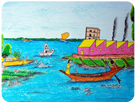 The
2010 International Year of Biodiversity is a global
attempt to draw the attention of one and all on the
importance of protection of biodiversity. Some 81 school
children from 2 localities in Chittagong (Chittagong
City and Sitakund Upazila) took part in an on-the-spot
art contest on 18 December 2010 organized by the Bay of
Bengal Programme Inter-Governmental Organisation and the
Marine Fisheries Office of the Department of Fisheries,
Government of Bangladesh. The
2010 International Year of Biodiversity is a global
attempt to draw the attention of one and all on the
importance of protection of biodiversity. Some 81 school
children from 2 localities in Chittagong (Chittagong
City and Sitakund Upazila) took part in an on-the-spot
art contest on 18 December 2010 organized by the Bay of
Bengal Programme Inter-Governmental Organisation and the
Marine Fisheries Office of the Department of Fisheries,
Government of Bangladesh.
|
|